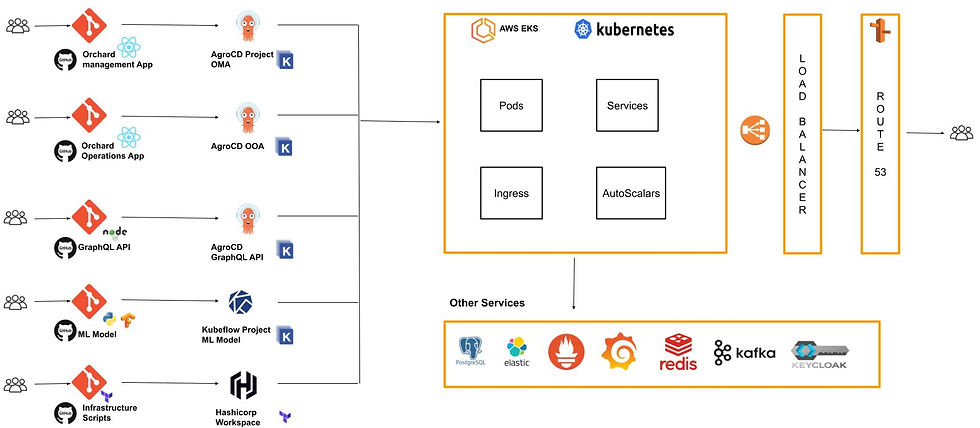AgriSciense Cloud-Native Architecture for Real-Time Pest Infestation Monitoring
- narendra soni
- May 24, 2024
- 3 min read
Introduction
At AgriSciense, we are developing a cutting-edge solution that integrates software to monitor and manage pest infestations in trees. Our system leverages the capabilities of embedded machine learning models running on Raspberry Pi Pico W devices to detect infestations in real-time and communicate the data to a cloud infrastructure for further analysis and action.
Software Architecture
Our software architecture follows GitOps and MLOps practices to ensure a robust, scalable, and maintainable cloud-native application. The following sections provide a detailed overview of our architecture, depicted in the below diagram.

Tools and Technologies
Infrastructure as Code (IaC): Terraform is used to define and provision our cloud infrastructure.
Continuous Integration/Continuous Deployment (CI/CD): GitHub Actions automate our CI/CD pipelines.
Configuration Management: ArgoCD manages the deployment and configuration of Kubernetes resources.
Containerization: Docker is used to create consistent runtime environments for our applications.
Cloud Provider: AWS provides the cloud infrastructure, including EKS (Elastic Kubernetes Service) for container orchestration.
MLOps: Kubeflow is used for managing machine learning workflows and deployments.
Cloud Infrastructure
Our cloud infrastructure is built on AWS and orchestrated using Kubernetes (EKS). The key components include:
Kubernetes Cluster
Pods: Units of deployment for our applications.
Services: Internal networking for applications.
Ingress: Manages external access to services.
Autoscalers: Ensure the cluster scales based on demand.
Load Balancer
Distributes incoming traffic to the appropriate services.
Route 53
DNS service to route end-user requests to the load balancer.
Other Services include the following :
PostgreSQL: Relational database for persistent storage.
Elasticsearch: Search and analytics engine
Prometheus: Monitoring and alerting toolkit.
Grafana: Visualization and analytics for monitoring data.
Redis: In-memory data structure store for caching and real-time analytics.
Kafka: Stream processing platform.
Keycloak: Identity and access management.
Workflow Overview
Development: Code is developed and pushed to GitHub repositories
CI/CD Pipeline: GitHub Actions automate testing and deployment processes.
Configuration Management: ArgoCD ensures Kubernetes resources are deployed and configured correctly.
Runtime: Applications run in Docker containers orchestrated by Kubernetes on AWS EKS.
Monitoring and Management: Prometheus and Grafana provide real-time monitoring, while Keycloak manages authentication and authorization.
Maintaining a Lean Development Team and Delivering High-Quality Software
Our architecture is designed to help our development team stay lean and deliver high-quality software efficiently:
Automation: By leveraging tools like Terraform, GitHub Actions, and ArgoCD, we automate infrastructure provisioning, CI/CD pipelines, and application deployments. This reduces the manual workload on the development team and minimizes human error.
Scalability: Kubernetes and autoscaling features ensure that our infrastructure scales automatically based on demand. This allows the team to focus on feature development rather than infrastructure management.
Consistency: Docker ensures that applications run consistently across different environments, from development to production. This reduces bugs and inconsistencies that arise from environment differences.
Monitoring and Observability: Prometheus and Grafana provide comprehensive monitoring and alerting, enabling the team to detect and resolve issues quickly before they impact users.
Security and Access Management: Keycloak simplifies the management of authentication and authorization, ensuring secure access to our services.
Collaboration: GitOps practices enable the team to collaborate more effectively by treating infrastructure as code. Changes are tracked, reviewed, and version-controlled, ensuring transparency and accountability.
By implementing these practices and tools, our architecture supports a lean development process and ensures the delivery of high-quality, reliable software to our users.
Conclusion
Our deep-tech startup's software architecture is designed to be scalable, reliable, and efficient, leveraging modern DevOps and MLOps practices. The integration of various tools and technologies ensures seamless data collection, processing, and analysis, enabling effective monitoring and management of pest infestations in trees. With a robust cloud-native architecture, we are well-equipped to handle the demands of our innovative solution while keeping our development team lean and focused on delivering high-quality software.

Comments